What is Breast Cancer?
Breast cancer is a type of cancer that starts in the breast. It can start in one or both breasts. Cancer starts when cells begin to grow out of control. Breast cancer occurs almost entirely in women, but men can get breast cancer, too.
It’s important to understand that most breast lumps are benign and not cancer (malignant). Non-cancer breast tumors are abnormal growths, but they do not spread outside of the breast. They are not life threatening, but some types of benign breast lumps can increase a woman’s risk of getting breast cancer. Any breast lump or change needs to be checked by a health care professional to find out if it is benign or malignant (cancer) and if it might affect your future cancer risk.
Where breast cancer starts
Breast cancers can start from different parts of the breast. The breast is an organ that sits on top of the upper ribs and chest muscles. There is a left and right breast and each one has mainly glands, ducts, and fatty tissue. In women, the breast makes and delivers milk to feed newborns and infants. The amount of fatty tissue in the breast determines the size of each breast.
The breast has different parts:
- Lobules are the glands that make breast milk. Cancers that start here are called lobular cancers.
- Ducts are small canals that come out from the lobules and carry the milk to the nipple. This is the most common place for breast cancer to start. Cancers that start here are called ductal cancers.
- The nipple is the opening in the skin of the breast where the ducts come together and turn into larger ducts so the milk can leave the breast. The nipple is surrounded by slightly darker thicker skin called the areola. A less common type of breast cancer called Paget disease of the breast can start in the nipple.
- The fat and connective tissue (stroma) surround the ducts and lobules and help keep them in place. A less common type of breast cancer called phyllodes tumor can start in the stroma.
- Blood vessels and lymph vessels are also found in each breast. Angiosarcoma is a less common type of breast cancer that can start in the lining of these vessels. The lymph system is described below.
A small number of cancers start in other tissues in the breast. These cancers are called sarcomas and lymphomas and are not really thought of as breast cancers.
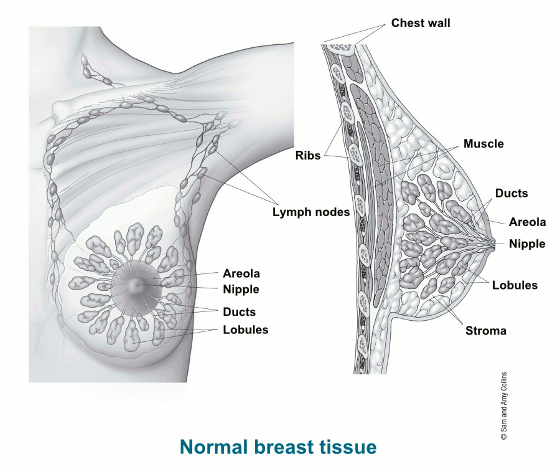
How breast cancer spreads
Breast cancer can spread when the cancer cells get into the blood or lymph system and then are carried to other parts of the body.
The lymph (or lymphatic) system is a part of your body’s immune system. It is a network of lymph nodes (small, bean-sized glands), ducts or vessels, and organs that work together to collect and carry clear lymph fluid through the body tissues to the blood. The clear lymph fluid inside the lymph vessels contains tissue by-products and waste material, as well as immune system cells.
The lymph vessels carry lymph fluid away from the breast. In the case of breast cancer, cancer cells can enter those lymph vessels and start to grow in lymph nodes. Most of the lymph vessels of the breast drain into:
- Lymph nodes under the arm (axillary lymph nodes)
- Lymph nodes inside the chest near the breastbone (internal mammary lymph nodes)
- Lymph nodes around the collar bone (supraclavicular [above the collar bone] and infraclavicular [below the collar bone] lymph nodes)
If cancer cells have spread to your lymph nodes, there is a higher chance that the cells could have traveled through the lymph system and spread (metastasized) to other parts of your body. Still, not all women with cancer cells in their lymph nodes develop metastases, and some women with no cancer cells in their lymph nodes might develop metastases later.
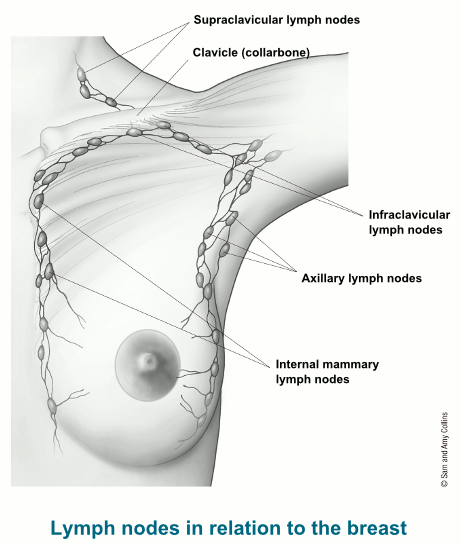
Types of breast cancer
There are many different types of breast cancer. The type is determined by the specific kind of cells in the breast that are affected. Most breast cancers are carcinomas. The most common breast cancers such as ductal carcinoma in situ (DCIS) and invasive carcinoma are adenocarcinomas, since the cancers start in the gland cells in the milk ducts or the lobules (milk-producing glands). Other kinds of cancers can grow in the breast, like angiosarcoma or sarcoma, but are not considered breast cancer since they start in different cells of the breast.
Breast cancers are also classified by certain types of proteins or genes each cancer might make. After a biopsy is done, breast cancer cells are tested for proteins called estrogen receptors and progesterone receptors, and the HER2 gene or protein. The tumor cells are also closely looked at in the lab to find out what grade it is. The specific proteins found and the tumor grade can help decide the stage of the cancer and treatment options.
Symptoms of breast cancer
What Are the Signs and Symptoms of Breast Cancer?
Every person should know the signs and symptoms of breast cancer, and any time an abnormality is discovered, it should be investigated by a healthcare professional.
Most people who have breast cancer signs and symptoms will initially notice only one or two, and the presence of these signs and symptoms do not automatically mean that you have breast cancer.
By performing monthly breast self-exams, you will be able to more easily identify any changes in your breasts. Be sure to talk to your healthcare professional if you notice anything unusual.
A Change In How The Breast Or Nipple Looks Or Feels
- Nipple tenderness or a lump or thickening in or near the breast or underarm area
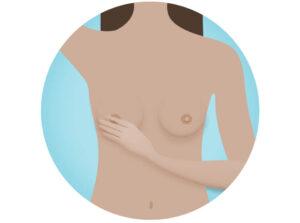
- A change in the skin texture or an enlargement of pores in the skin of the breast (some describe this as similar to an orange peel’s texture)
- A lump in the breast (It’s important to remember that all lumps should be investigated by a healthcare professional, but not all lumps are cancerous.)
A Change In The Breast Or Nipple Appearance
- Any unexplained change in the size or shape of the breast
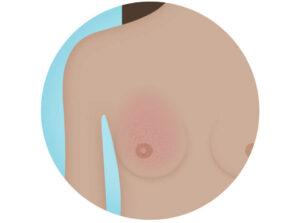
- Dimpling anywhere on the breast
- Unexplained swelling of the breast (especially if on one side only)
- Unexplained shrinkage of the breast (especially if on one side only)
- Recent asymmetry (unequal or lack of sameness) of the breasts. Although it is common for women to have one breast that is slightly larger than the other, if the onset of asymmetry is recent, it should be checked.
- Nipple that is turned slightly inward or inverted
- Skin of the breast, areola, or nipple that becomes scaly, red, or swollen or may have ridges or pitting resembling the skin of an orange
Any Nipple Discharge—Particularly Clear Discharge Or Bloody Discharge
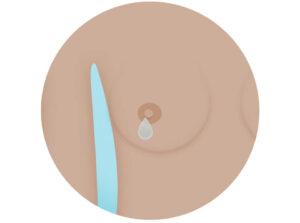 It is also important to note that a milky discharge that is present when a woman is not breastfeeding should be checked by her doctor, although it is not linked with breast cancer.
It is also important to note that a milky discharge that is present when a woman is not breastfeeding should be checked by her doctor, although it is not linked with breast cancer.
Let your doctor know about any nipple discharge, clear, bloody or milky. The most concerning discharges are bloody or clear.
Risk Factors of breast cancer
The following are risk factors for breast cancer:
Older age
Besides being a woman, older age is the main risk factor for breast cancer. The chance of getting breast cancer increases as a woman gets older. A 30-year-old woman has about a 1 in 200 chance of being diagnosed with breast cancer in the next 10 years, while a 70-year-old woman has a 1 in 25 chance.
Women aged 50 to 69 years who have screening mammograms have a lower chance of dying from breast cancer than women who do not have screening mammograms. Screening by mammography decreases breast cancer mortality by identifying cases for treatment at an earlier stage.
A personal history of breast cancer or benign (noncancer) breast disease
Women with any of the following have an increased risk of breast cancer:
- A personal history of invasive breast cancer, ductal carcinoma in situ (DCIS), or lobular carcinoma in situ (LCIS).
- A personal history of benign (noncancer) breast disease.
Inherited risk of breast cancer
Women with a family history of breast cancer in a first-degree relative (mother, sister, or daughter) have an increased risk of breast cancer.
Women who have inherited changes in the BRCA1 and BRCA2 genes or in certain other genes have a higher risk of breast cancer. The risk of breast cancer caused by inherited gene changes depends on the type of gene mutation, family history of cancer, and other factors.
Dense breast tissue
Having breast tissue that is dense on a mammogram is a factor in breast cancer risk. The level of risk depends on how dense the breast tissue is. Women with very dense breasts have a higher risk of breast cancer than women with low breast density.
Increased breast density is often an inherited trait, but it may also occur in women who have not had children, have a first pregnancy late in life, take postmenopausal hormones, or drink alcohol.
Reproductive history resulting in greater exposure to estrogen
Estrogen is a hormone made by the body. It helps the body develop and maintain female sex characteristics. Being exposed to estrogen over a long time may increase the risk of breast cancer. Estrogen levels are highest during the years a woman is menstruating.
The following factors in a woman’s reproductive history increase the length of time her breast tissue is exposed to estrogen and may increase the risk of breast cancer:
- Early menstruation: Beginning to have menstrual periods before age 12 increases the number of years the breast tissue is exposed to estrogen.
- Starting menopause at a later age: The more years a woman menstruates, the longer her breast tissue is exposed to estrogen.
- Older age at birth of first child or never having given birth: Pregnancy lowers a woman’s lifetime number of menstrual cycles. Breast tissue is exposed to more estrogen for longer periods of time in women who become pregnant for the first time after age 35 or who never become pregnant.
Taking hormone therapy for symptoms of menopause
Hormones, such as estrogen and progesterone, can be made into a pill form in a laboratory. Estrogen, progestin, or both may be given to replace the estrogen no longer made by the ovaries in postmenopausal women or women who have had their ovaries removed. This is called hormone replacement therapy (HRT) or hormone therapy (HT). Estrogen therapy that began close to the time of menopause is associated with an increased risk of developing breast cancer. Estrogen therapy that began at or after menopause is associated with an increased risk of developing endometrial cancer and total cardiovascular disease, especially stroke. The risk of breast cancer does not decrease after women stop taking estrogen. Combination HT is estrogen combined with progestin. This type of MHT increases the risk of breast cancer. Studies show that when women stop taking estrogen combined with progestin, the risk of breast cancer decreases.
Obesity
Obesity increases the risk of breast cancer, especially in postmenopausal women who have not used hormone replacement therapy.
Drinking alcohol
Drinking alcohol increases the risk of breast cancer. The level of risk rises as the amount of alcohol consumed rises.
Wear it pink
Every year during Breast Cancer Awareness Month, we wear pink, offer free screening and education, and help provide hope to those affected by cancer. Will you join us?
Contact us on +233244945805 or ramsri@gaec.gov.gh.

